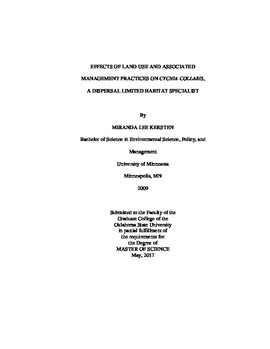| dc.contributor.advisor | Baum, Kristen A. | |
| dc.contributor.author | Kersten, Miranda Lee | |
| dc.date.accessioned | 2018-03-13T18:15:55Z | |
| dc.date.available | 2018-03-13T18:15:55Z | |
| dc.date.issued | 2017-05-01 | |
| dc.identifier.uri | https://hdl.handle.net/11244/54550 | |
| dc.description.abstract | Milkweed (Asclepias spp.) plants provide habitat for several insect species, including the unexpected cycnia (Cycnia collaris), a milkweed dependent moth that has limited dispersal abilities, and of which, there have been very few published studies. Land use may influence the distribution and abundance of unexpected cycnia populations, as well as parasitism on the larval stage by tachinid flies and ichneumonid wasps. The objective of this research was to evaluate the distribution and abundance of unexpected cycnia across land uses (roadsides, managed grasslands, and rangelands) and associated land management practices (mowing and prescribed fire) in north-central Oklahoma and to document parasitism rates to evaluate the potential role (sources versus sinks) of land uses for this species. I also evaluated factors influencing the distribution of unexpected cycnia throughout its range with an ecological niche model. I measured the weekly abundance of A. viridis, the most common milkweed species in this area, and unexpected cycnia on 5 m x 50 m transects from mid-April to early November in 2015 and 2016. I also measured milkweed characteristics along the transects. Fourth and fifth instar cycnia (having had the opportunity to be exposed to parasites in the field) were collected and reared individually in the lab to estimate parasitism rates. Annually, milkweed abundances varied among land uses but unexpected cycnia abundances did not. Timing of land management affected milkweed availability later in the growing season. Many milkweed characteristics also differed across land uses. In 2015, parasitism did not differ among land uses, but it was higher in rangelands in 2016. The dominant parasitoid varied seasonally. Parasitism by ichneumonid wasps occurred mainly in the first half of the season and then again towards the end, while tachinid fly parasitism was more common in the second half of the season. Across the entirety of its range, unexpected cycnia distribution was most influenced by annual precipitation and by land cover. | |
| dc.format | application/pdf | |
| dc.language | en_US | |
| dc.rights | Copyright is held by the author who has granted the Oklahoma State University Library the non-exclusive right to share this material in its institutional repository. Contact Digital Library Services at lib-dls@okstate.edu or 405-744-9161 for the permission policy on the use, reproduction or distribution of this material. | |
| dc.title | Effects of Land Use and Associated Management Practices on Cycnia Collaris, a Dispersal Limited Habitat Specialist | |
| dc.contributor.committeeMember | Hickman, Karen R. | |
| dc.contributor.committeeMember | Wilson, Gail W. T. | |
| osu.filename | Kersten_okstate_0664M_15108.pdf | |
| osu.accesstype | Open Access | |
| dc.description.department | Zoology | |
| dc.type.genre | Thesis | |
| dc.type.material | text | |
